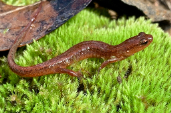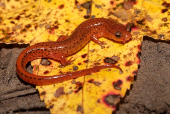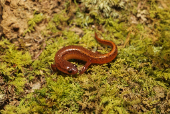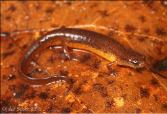Carolina Sandhills Salamander (Eurycea arenicola)
Description: Eurycea arenicola is a small, slender member of the E. bislineata complex with an overall total length of 56.0 to 89.1 mm, a snout-vent length of 28.6 to 41.3 mm, and a tail length that is 42.4 to 55.6% of the total length. Males range in total length from 56.0 to 89.1 mm, in snout-vent length from 28.6 to 41.3 mm, and in tail length from 27.4 to 49.6 mm. Females range in total length from 59.9 to 87.8 mm, in snout-vent length from 28.7 to 40.3 mm, and in tail length from 27.0 to 48.2 mm. The head is longer than wide and has the same width as the body. The short snout is almost truncate in the dorsal view and slightly rounded and protruding over the jaw in the profile. The nostrils are parallel to the snout tip and located close to the snout tip. They are visible from the dorsal view. A weak nasolabial groove can be seen. Males have nasal cirri that are located halfway between the nares and the snout tip. The interorbital distance is twice the width of the upper eyelid. The eye diameter is shorter than the snout length. Males have a weak fan-shaped mental gland on the anterior half of the chin. The trunk is marginally wider than deep and has fourteen costal grooves. The tail is slender and laterally compressed. Cross-sections of the tail at the base are oval and tapers to the tip. There are no fins on the tail. The forelimbs are small with fingers that have relative lengths. The hind limbs are longer than the forelimbs and have toes with relative lengths. The digits don't have webbing.
Habitat: It inhabits the longleaf pine ecosystem, where it lives in springs and blackwater rivers, as with other endangered amphibians restricted to this ecosystem such as the Pine Barrens tree frog (Dryophytes andersonii).
Range: It is found in the Carolina Sandhills. Although all known records are from North Carolina, one specimen was found only 2 miles from the border with South Carolina, so it may be present there as well.
Found in these States:
NC
Diet: Diet and feeding behavior of adult Carolina Sandhills salamanders are poorly known, but they likely feed on a wide variety of small invertebrates, as do other members of the E. bislineata complex
Reproduction: Carolina Sandhills salamanders breed in springs and blackwater streams with substrates of sand, gravel, clay, or detritus at elevations of 51 to 150 meters within the longleaf pine ecosystem. Courtship has not been described, but a male and gravid female were found together beneath a board on 5 December, and gravid females have been found in late fall and early winter. Eggs have been found attached to submerged root masses in streams. Oviposition typically occurs in winter, with natural nests having been found in February and March. Limited observations suggest that nests are attended by females. Clutch size is unknown, but probably comparable with other members of the E. bislineata complex.
Status: This species has a restricted distribution in North Carolina, USA with an extent of occurrence (EOO) of 3,221 km2. While the majority of its historical Longleaf Pine habitat has been lost, the remaining habitat within its range are managed within public and private conservation lands. Without this protection, the species' habitat would likely be fragmented and further decline, resulting in a threatened category. It is therefore listed as Near Threatened.
»» Kingdom: Animalia - Animals
»» Phylum: Chordata - Chordates
»» Subphylum: Vertebrata - Vertebrates
»» Class: Amphibia - (Amphibians)
»» Order: Caudata - Salamanders
»» Family: Plethodontidae - Lungless Salamanders
»» Genus: Eurycea
»» Species: Eurycea arenicola - Carolina Sandhills Salamander
This article uses material from the Wikipedia article "Carolina Sandhills Salamander", which is released under the Creative Commons Attribution-Share-Alike License 3.0. Content may have been omitted from the original, but no content has been changed or extended.
|













